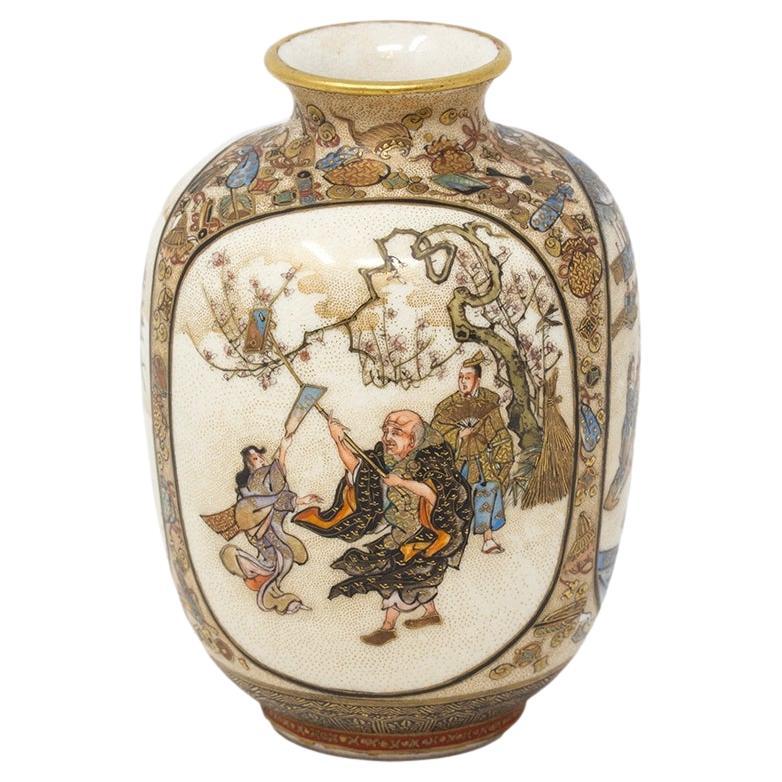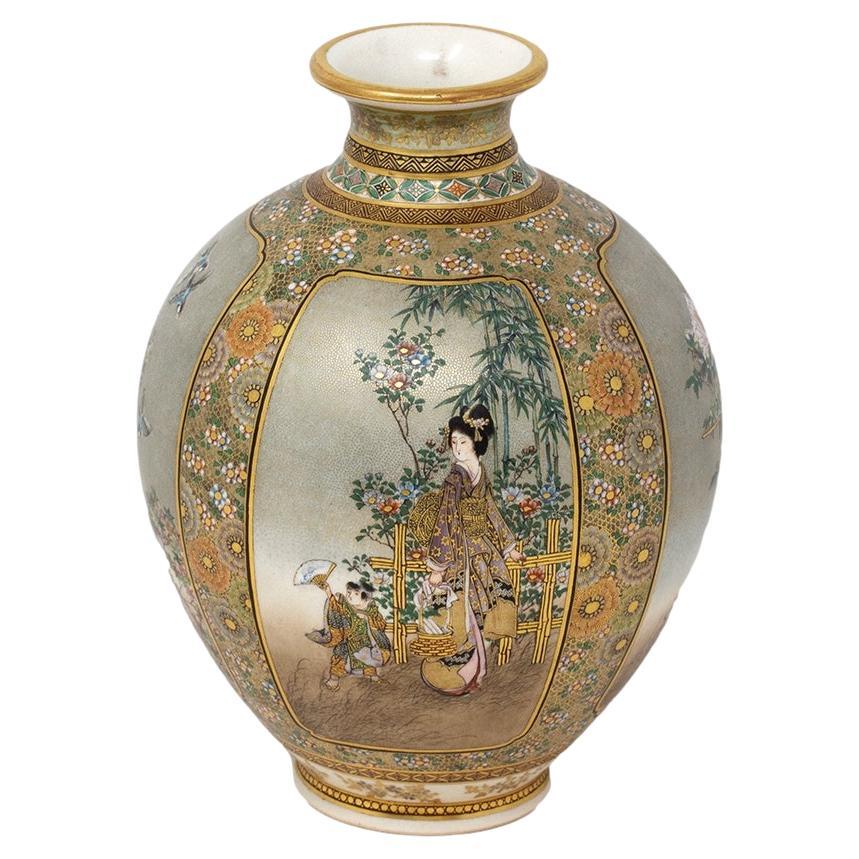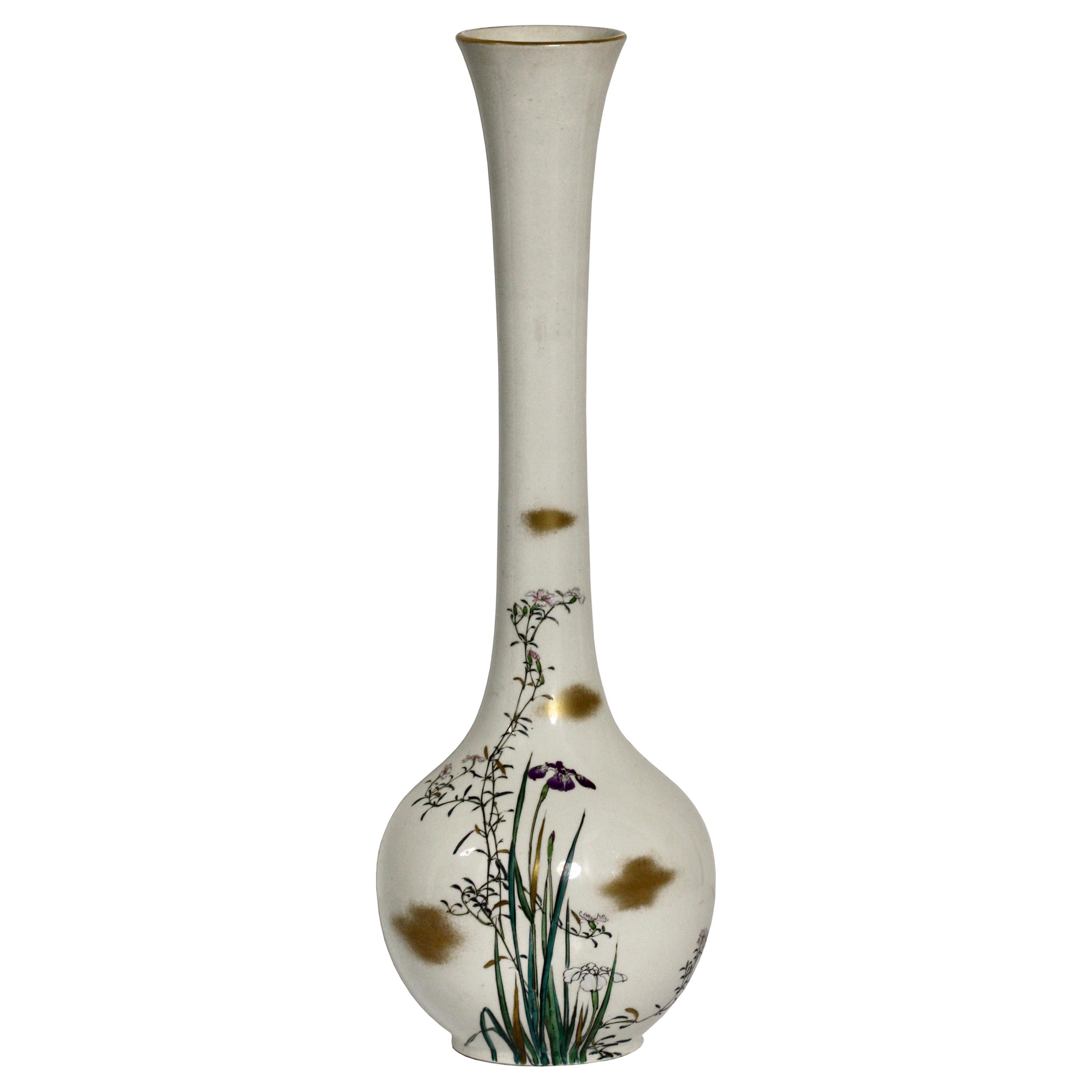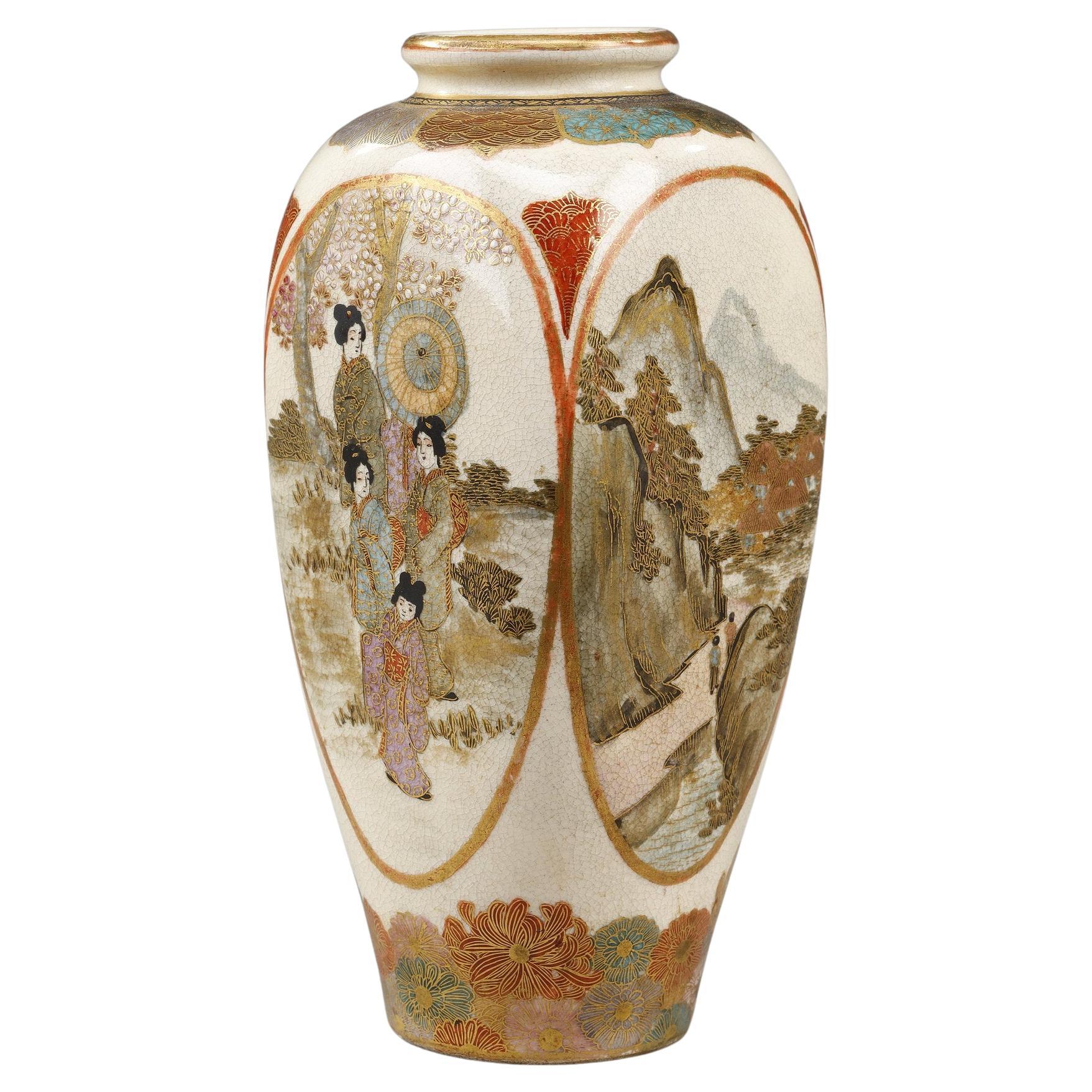Items Similar to Japanese Meiji Period Satsuma Vase Painted by Ryozan for the Yasuda Company
Want more images or videos?
Request additional images or videos from the seller
1 of 21
Japanese Meiji Period Satsuma Vase Painted by Ryozan for the Yasuda Company
About the Item
The vase of slightly bulbous form potted with a tapered body reaching a slightly pinched neck and rolled top rim is beautifully decorated with two large scenes. The first scene features a mountainous region with a river flowing through the centre with beautiful wash colours of green. A Bamboo plant can be seen hanging over the left of the scene with two Geishas walking amongst the flowers with children running around them. Further Geishas can be seen to the far right of the vase in front of a traditional Japanese building. The second scene an upstream version of the first with spectacular pink cherry blossom amongst a central river breaking the land in two with further figures with children. The scenes bordered by a strip gilt border featuring alternating images two depicting a Minogame. The shoulder of the vase is beautifully finished with complex rings of geometric scrolling borders with shades of teal, butterflies and one hundred treasures style decoration above gilt cartouches of the imperial style Kiku (chrysanthemum). The vase is signed to the base Dai Nippon, Kyoto Tojiki, Goshi Kaisha, Okamoto Ryozan 京都陶, 磁器合, 資会社,岡曰本亮山 with the Yasuda Company Mark (Yasuda Kyoto Tojiki Goshikaisha) which translates as the Yoshida Kyoto Ceramic Joint Stock Company and dates to the Meiji Period (1868-1912) circa 1900.
Yasuda Company was founded in 1896 by Gensei and Yoshizaburo Yasida two brothers from Kyoto. The companies full name is Yasuda Kyoto Tojiki Goshikaisha which translates to Yoshida Kyoto Ceramic Joint Stock Company. They were a manufacturer and dealership based in Kyoto and active during the second half of the Japanese Meiji-era specialising in decorative works including Cloisonne and Ceramics, today they are best-known for their Satsuma pottery wares. The company gained a good reputation and great respect for their high quality works which were executed by some of the best artists of their time. As well as Okamoto Ryozan, they worked with celebrated artists such as Sozan, Kizan, Hozan and Seikozan.
Ryozan was born Nakamura Tatsunosuke and was trained by the legendary 10th generation potter Nishimura Zengoro who himself, used the artist’s name “Ryozan”. After Nishimura’s death in 1851, Nakamura Tatsunosuke adopted the name “Okatomo Ryozan” in order to pay tribute to and honour his master. Ryozan went on to become the Head Artist at the Yasuda Company of Kyoto where he confirmed his reputation as one of the great Satsuma artists of the generation.
Minogame 蓑亀 are long-lived turtles with long strands of algae growing from their shells. The algae drapes down from their shells and resembles a farmer’s straw raincoat (mino) from which they get their name. They are considered very auspicious creatures throughout East Asia. The long algae on their backs is reminiscent of the long beards of sages and wise men. Because of this and their long life span, they are a symbol of long life and prosperity and appear frequently in paintings, sculpture in Japanese culture. The minogame is a symbol of longevity and happiness and has an important role in the well-known legend of Urashima Taro.
Meiji Period was an era of Japanese history that spanned from 1868 to 1912. It was the first half of the Empire of Japan, when the Japanese people began to build a paradigm of a modern, industrialised nation state and emergent great power, influenced by Western countries and aesthetics. As a result of radically different ideas, the changes to Japan were profound and it affected the social structure, politics, economy, military, and foreign relations across the board. The period corresponded to the reign of Emperor Meiji and was preceded by the Keio era and was succeeded by the Taisho era.
Cultural Art during the Meiji Period was of particular interest to the government and they overhauled the art export market which in turn promoted Japanese arts via various world’s fairs, beginning in Vienna at the world fair in 1873. The government heavily funded the fairs and took an active role organising how Japan’s culture was presented to the world including creating a semi-public company named Kiritsu Kosho Kaisha (First Industrial Manufacturing Company). The Kiritsu Kosho Kaisha was used to promote and commercialise exports of Japanese art and established the Hakurankai Jimukyoku (Exhibition Bureau) to maintain quality standards. For the 1876 Centennial International Exhibition in Philadelphia, the Japanese government created a Centennial Office and sent a special envoy to secure space for the 30,000 items that would be displayed. The Imperial Household also took an active interest in arts and crafts, commissioning works by select artists to be given as gifts for foreign dignitaries further emphasising the high quality and importance of Japanese art. Just before the end of the 19th century in 1890, the Teishitsu Gigeiin (Artist to the Imperial Household) system was created to recognise distinguished artists. These artists were selected for their exceptionally high quality wares and talent in their own industry. Over a period of 54 years Seventy artists were appointed, amongst these were ceramicist Makuzu Kozan and cloisonné enamel artist Namikawa Yasuyuki.
Satsuma ware is a type of earthenware pottery originating from the Satsuma province in Southern Kyushu, Japan’s third largest island.
Measurements (centimetres) 18.5cm High x 15.5 Diameter
- Dimensions:Height: 7.28 in (18.5 cm)Diameter: 6.1 in (15.5 cm)
- Style:Meiji (Of the Period)
- Materials and Techniques:
- Place of Origin:
- Period:1900-1909
- Date of Manufacture:Cica 1900
- Condition:
- Seller Location:Newark, GB
- Reference Number:
About the Seller
5.0
Vetted Seller
These experienced sellers undergo a comprehensive evaluation by our team of in-house experts.
Established in 2019
1stDibs seller since 2022
17 sales on 1stDibs
Typical response time: 3 hours
- ShippingRetrieving quote...Ships From: Newark, United Kingdom
- Return PolicyA return for this item may be initiated within 14 days of delivery.
More From This SellerView All
- Japanese Hand Painted Meiji Period Satsuma VaseBy KinkozanLocated in Newark, EnglandSquat Bulbous Form From our Japanese collection, we are delighted to offer this Japanese Meiji Period Satsuma Vase. The Satsuma vase of squat bulbous form with a tightly pinched nec...Category
Antique Late 19th Century Japanese Meiji Ceramics
MaterialsCeramic, Earthenware, Pottery
- Japanese Meiji Period Satsuma Vase by KinkozanBy KinkozanLocated in Newark, EnglandThe vase is potted in globular form with a tightly pinched neck and rolled top rim beautifully decorated with four highly detailed individual panelled scenes. The first a Geisha bari...Category
Antique Late 19th Century Japanese Meiji Ceramics
MaterialsCeramic, Earthenware, Pottery
- Japanese Meiji Period Satsuma Bowl KinkozanBy KinkozanLocated in Newark, EnglandFrom our Japanese collection, we are delighted to offer this Japanese Meiji period Satsuma Bowl by Kinkozan. The earthenware bowl with pinched rim extensively decorated on both the exterior and interior. The bowl with a cobalt blue base glaze decorated to the borders with gilt shippo-tsunagi (linked-cash) with scattered medallion roundells. Around the exterior two elongated scenes are featured, one with boys playing games in a courtyard with the other featuring seated scholars in full dress both with raised enamel decoration. The interior features a central scene with Samurai warriors in training fully armoured with swords in a courtyard with landscapes scenes to the background. The central scene bordered by further stylised shippo-tsunagi type decoration with a greek key rim border. The bowl signed to the base Kinkozan dating to the Meiji Period (1868-1912) circa 1900. Shippo-Tsunagi (linked-cash) or seven treasures, is a traditional Japanese geometric pattern that combines four ellipses in a circle. These ellipses repeat outward to then create more circles, symbolising eternal peace and happiness. Kinkozan the Kinkozan family have been associated with pottery dating back to 1645. They went on to become the largest producer of Satsuma ware by one individual company, from the end of the 19th century until 1927 after which the factory closed. By the 1850s Kobayashi Sobei (1824-84), Kinkozan Sobei...Category
Antique Early 1900s Japanese Meiji Ceramics
MaterialsCeramic, Earthenware, Pottery, Faux Leather
- Japanese Meiji Period Satsuma Bowl Signed SuizanLocated in Newark, EnglandJapanese Meiji period satsuma scalloped shaped bowl. The bowl of beautiful form with gilt pin-striping and dotting to the accented areas. The exterior decorated with multiple fish swimming around the outside with small flower sprays between. To the inside a painted netting covers the bowl with butterflies and further floral sprays. The centre decorated with representations of each of the woodcut prints from Hiroshige's Tokaido gojusan tsugi (53 Stations of the Tokaido Road). To the base a stylised cartouche signature within an oval for Suizan. This Japanese satsuma bowl...Category
Antique Late 19th Century Japanese Meiji Ceramics
MaterialsCeramic, Earthenware, Pottery
- Antique Japanese Meiji Period Satsuma Koro KizanLocated in Newark, EnglandMeiji Period (1868-1912) From our Japanese collection, we are pleased to offer this Antique Japanese Meiji Period Satsuma Koro by Kizan. The Koro of squat bombe form raised upon an...Category
Antique 1890s Japanese Meiji Ceramics
MaterialsCeramic, Earthenware
- Japanese Meiji Period Satsuma Floor VasesLocated in Newark, EnglandThe vases of large oval form potted from earthenware with pinched neck and base stood upon a splayed circular foot. The vases extensively decorated with a continuous scene with polychrome colours and raised enamels featuring a large central white elephant and various figures. The top and bottom bordered by arched gilt decoration and gilded rims. The bases signed by a three character mark in red 新井造 Arai Zo (made by Arai). The vases date to the Meiji period (1868-1912) and are large in size measuring 46cm High. Meiji Period is an era of Japanese history that spanned from 1868 to 1912. It was the first half of the Empire of Japan, when the Japanese people began to build a paradigm of a modern, industrialised nation state and emergent great power, influenced by Western countries and aesthetics. As a result of radically different ideas, the changes to Japan were profound and it affected the social structure, politics, economy, military, and foreign relations...Category
Antique Late 19th Century Japanese Meiji Vases
MaterialsCeramic, Earthenware
You May Also Like
- Antique Japanese Meiji Satsuma Painted VaseBy SatsumaLocated in LA CIOTAT, FRA petite and beautiful hand-decorated ceramic baluster vase, painted all around with traditional Japanese motifs, including native flora, birds and bamboo stems on a creamy glazed background. The colour palette is bold and bright, with highlights of green, red and blue, together with plentiful gilt relief...Category
Antique 19th Century Japanese Meiji Ceramics
MaterialsCeramic
- Kinkozan, Japanese Satsuma Vase, Meiji PeriodBy KinkozanLocated in West Palm Beach, FLKinkozan, Japanese Satsuma vase, Meiji Period (1868-1912) Of baluster form with an elongated neck decorated in polychrome enamels and gilt on a clear crackle glaze in an Art-Nouvea...Category
20th Century Ceramics
MaterialsCeramic
- Japanese Satsuma Earthenware Vase, Meiji PeriodLocated in West Palm Beach, FLJapanese Satsuma Earthenware Vase, Meiji Period, 1868-1912, of baluster form, the decorated in poly-chrome enamels and gilt on a clear crackle glaze with a Daimyo procession, the nec...Category
20th Century Ceramics
MaterialsCeramic
- Satsuma porcelain vase from the Meiji period, JapanLocated in Paris, FRSmall porcelain vase in Satsuma earthenware. The 4-sided body is decorated in polychrome and gold enamels with geishas in a garden, a mountain landscape, a bird on a flowering branch...Category
Antique 1890s Japanese Ceramics
MaterialsPorcelain
- Satsuma Earthenware Vase, by Kinkozan, Japanese, Meiji PeriodBy SatsumaLocated in West Palm Beach, FLA Satsuma Earthenware Vase, by Kinkozan, Japanese, Meiji period (1868-1912) decorated in polychrome enamels and gilt over a clear, crackled glaze, delicately painted with ladies and men, the reverse with a flowering garden with sprays of flowers, the neck with geometric and floral designs, a band of kifu heads in silver and gilt above the foot, on a midnight-blue ground, signed Kinkozan zo...Category
Antique 1860s Vases
MaterialsEarthenware
- Japanese Meiji Satsuma Polygonal VaseBy Kyoto PotteryLocated in Gainesville, FLJapanese Meiji Satsuma polygonal vase with four panels. Each panel shows a different scene. Fine gilding and hand enameling. Marked on the bottom with shimadzu mon.Category
Antique Late 19th Century Asian Meiji Ceramics
MaterialsPottery
Recently Viewed
View AllMore Ways To Browse
Imperial Nippon Hand Painted Vase
Bamboo And Cherry Blossoms Scroll
Celadon Blue And White
Celadon Bird Motif
Imperial Nippon Hand Painted Vase
Antique Chinese Cloisonne Sold
Chinese Porcelain Blanc De Chine Goddess Guanyin
Antique Chinese Ding
Arita Porcelain Box
Large White Italian Porcelain Asian Sculpture
Japanese Sake Tokkuri
Antique Japanese Porcelain Okimono
Blanc De Chine Quan Yin
Blanc De Chine Quan
Chinese Porcelain Censor
Hatcher Cargo Porcelain
Dragon Pheonix
Kenzan Pottery





